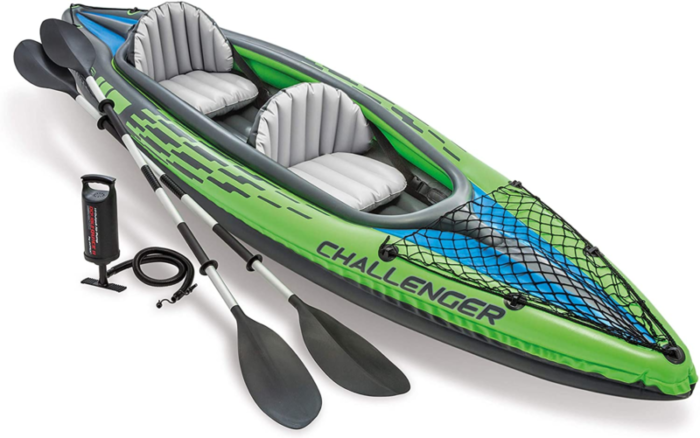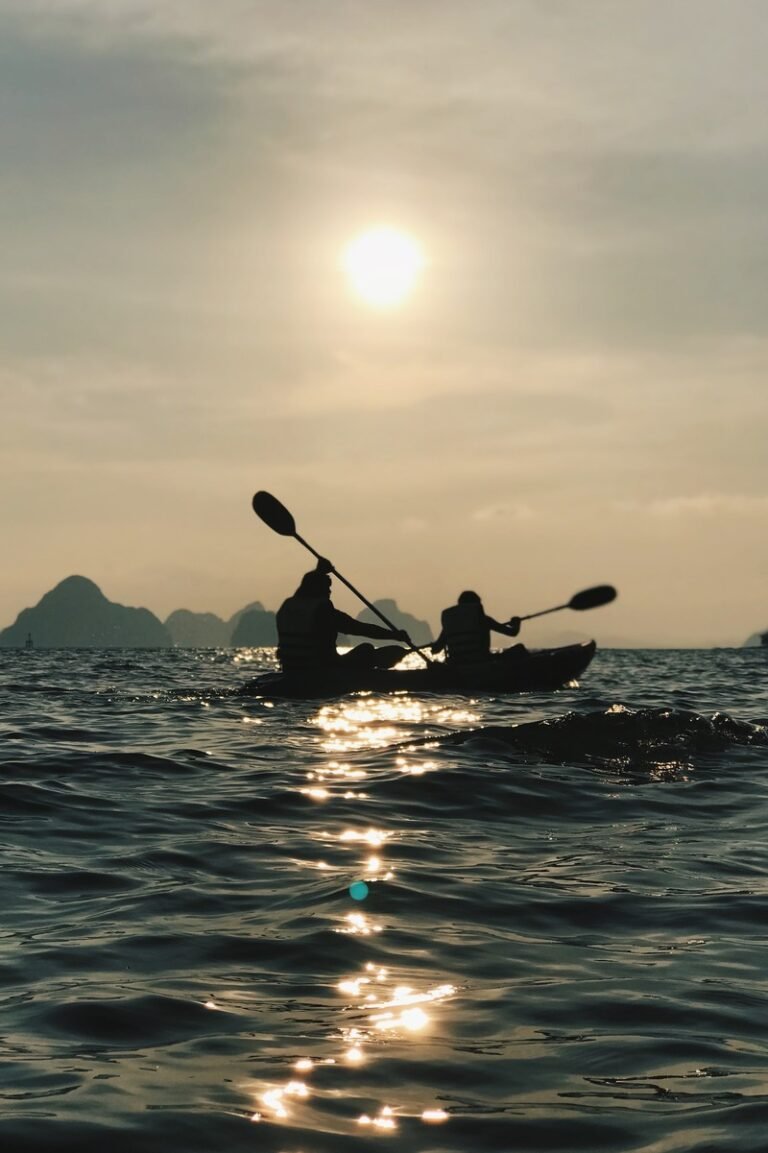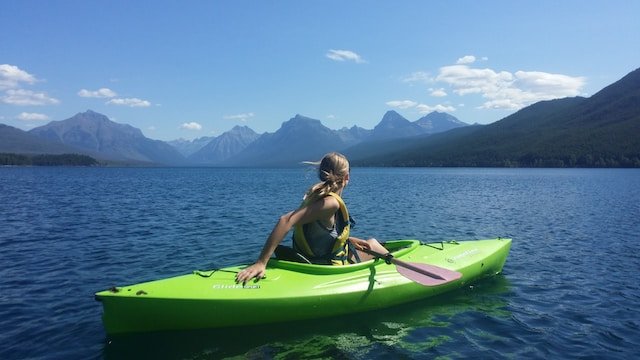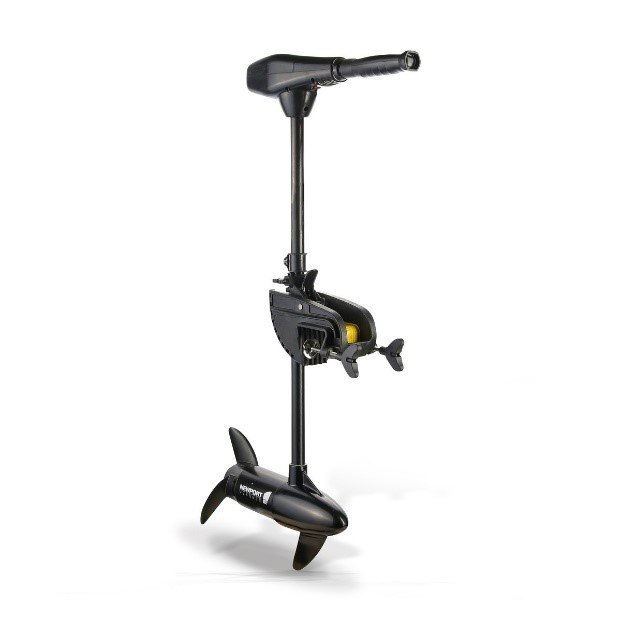Una guida dettagliata al kayak notturno
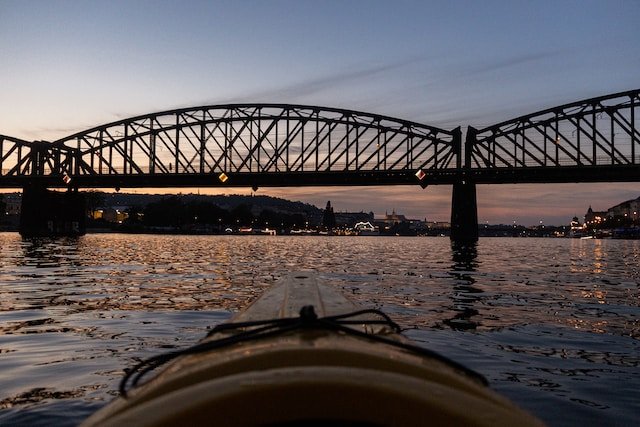
Guida al kayak notturno
Quando la maggior parte delle persone pensa al kayak, immagina di remare in un corso d'acqua preferito durante il giorno. Il fatto che tu stia leggendo questo articolo dimostra che vuoi verificare questo fatto, vuoi essere sicuro di poter goderti il tuo sport preferito indipendentemente dal fatto che sia giorno o notte.
Fare kayak di notte è infatti possibile e, come puoi immaginare, è molto diverso dal kayak di giorno. Per prima cosa la maggior parte delle persone va in pensione di notte, quindi probabilmente sarai in acqua da solo, senza alcuna folla lì a rovinare la magia.
La pesca è più divertente di notte e le stelle, il chiaro di luna o le luci della città che si riflettono sull'acqua offrono una vista meravigliosa. Ti innamorerai di nuovo della natura.
Tuttavia, prima di iniziare a fare kayak di notte, devi familiarizzare con ciò che ciò comporta. È importante che tu impari le regole.
Tuffati in questo articolo in cui ti viene spiegato tutto ciò che devi sapere sul kayak notturno per prepararti a una sessione di pagaiata sull'acqua divertente e sicura.
È legale andare in kayak di notte?
La domanda se il kayak di notte sia legale o meno è una domanda comunemente posta dai kayakisti che desiderano ampliare i propri orizzonti in kayak e godersi il fascino dell'acqua quando il sole non è più nel cielo e l'acqua è libera dalla folla.
Il kayak notturno può essere un'esperienza pacifica e serena. Può anche essere pericoloso e quindi non è raccomandato senza la preparazione adeguata e l'attrezzatura di sicurezza. È legale andare in kayak di notte?
In generale sì, ma ci sono alcune eccezioni che variano da stato a stato. Qualsiasi parco statale o nazionale che proibisca il kayak notturno molto probabilmente lo farà perché può essere pericoloso e dannoso per la fauna selvatica, ma tutto sommato, dovresti essere in grado di fare kayak di notte senza attirare problemi da parte delle forze dell'ordine.
Poiché le leggi relative al kayak notturno variano da stato a stato, spetta a te verificare le leggi del tuo stato per assicurarti di non violarle.
La Guardia Costiera che regola le attività nautiche in tutti gli stati classifica i kayak come imbarcazioni a propulsione umana o a remi e, come tali, è prevista un'illuminazione standard.
La Guardia Costiera si aspetta che chiunque vada in kayak di notte abbia le stesse luci di una barca a vela o una torcia o una torcia elettrica se impossibilitato. La regola è riportata di seguito.
“Una nave a remi può mostrare le luci prescritte in questa regola per le navi a vela, ma se non lo fa, deve mostrare una luce bianca tutt’intorno o avere a portata di mano una torcia elettrica o un fanale illuminato che mostri una luce bianca che deve essere esibito in tempo sufficiente per evitare una collisione”.
Oltre a questa regola, in ogni stato esistono leggi specifiche e precauzioni di sicurezza guidare il kayak di notte. Sta a te studiarli e rispettarli.
È sicuro andare in kayak di notte?
Come tutti sappiamo, avere il permesso di fare qualcosa ed essere al sicuro mentre lo si fa sono due cose diverse. Non dovrebbe quindi sorprendere apprenderlo il kayak di notte è intrinsecamente pericoloso, ancor più che andare in kayak durante il giorno.
I soliti pericoli del kayak diurno includono disidratazione, annegamento, capovolgimento, ipotermia e brutto tempo, ma la notte aggiunge all'elenco condizioni di scarsa illuminazione, scarsa visibilità e un'alta probabilità di essere disorientati.
Dico questo non per spaventarvi dal kayak notturno, ma per aiutarvi a prepararvi. Sapere cosa aspettarti dal tuo viaggio e non sottovalutare i pericoli dei tuoi sforzi è il primo passo per garantire la tua sicurezza in acqua.
Il problema principale del kayak notturno è la scarsa visibilità. Il senso principale di un kayaker è la vista. Dipende da esso per navigare in sicurezza sulla sua nave e la notte porta con sé il suo fascino condizioni di scarsa illuminazione.
Garantire la tua sicurezza implica quindi investire nel vedere ciò che ti circonda e nel farti vedere facilmente. Non dare mai per scontato che gli altri in acqua seguano le precauzioni di sicurezza. Seguiteli sempre per tutti ed eviterete incidenti.
Il prossimo problema del kayak notturno è il disorientamento. Noterai che una volta che il sole tramonta, anche un'area molto familiare inizia a sembrare estranea e, se non si presta attenzione, potresti rimanere disorientato e alterare il tuo percorso.
Correggere una rotta alterata di notte è più difficile di quanto sembri, quindi vuoi evitare del tutto questa situazione difficile. Presta maggiore attenzione a ciò che ti circonda di notte rispetto a durante il giorno per garantire la tua sicurezza.
L’ultima cosa a cui dovresti prestare attenzione è la fauna selvatica. Prima di andare in kayak in un corso d'acqua, sia di giorno che di notte, dovresti prenderti cura di sapere quali esseri viventi condivideranno l'acqua con te.
Devi prestare particolare attenzione di notte, poiché gli animali sedentari durante il giorno potrebbero essere più attivi di notte (come gli alligatori) e non vuoi affrontare un animale se non sei in grado di vedere correttamente l'ambiente circostante.
Regole che regolano il kayak notturno
Indipendentemente dal fatto che si usi il kayak di giorno o di notte, le regole di sicurezza del kayak rimangono invariate.
Sii consapevole di ciò che ti circonda, sii pronto per le emergenze, controlla le previsioni del tempo prima di pianificare il tuo viaggio, ecc. Naturalmente, il kayak di notte richiede regole di sicurezza aggiuntive, e tali regole sono discusse di seguito.
Regola 1: assicurati che gli altri possano vederti facilmente
Come ormai saprai, il problema più grande del kayak di notte è la scarsa visibilità, quindi assicurarsi che gli altri possano vederti è un passo significativo per prevenire le collisioni. Puoi renderti visibile in due modi, utilizzando le luci e/o il suono del kayak.
Se scegli di utilizzare il suono come mezzo per essere visto, ti consigliamo di utilizzare una tromba d'aria marina o un fischio a lungo raggio. Assicurati solo che il livello di decibel sia almeno di 120 dB e superiore e sarai a posto.
L'idea è di fare abbastanza rumore affinché chiunque si avvicini a te sappia subito che c'è qualcuno là fuori. Se non puoi permetterti una luce sufficientemente intensa e senti di dover andare in kayak quella notte, non dovresti trascurare l'uso del suono per essere visto.
Se preferisci la luce come metodo per essere visto, il luce del kayak che usi dovrebbe essere approvato dalla Guardia Costiera.
Puoi utilizzare una luce bianca a 360 gradi montata su un palo del tuo kayak per renderti visibile agli altri o, per lo meno, è necessaria una torcia per la tua sicurezza. Assicurati di essere facilmente visibile sull'acqua e gli incidenti saranno lontani da te.
Anche avere le luci di emergenza è una parte importante per essere visti. Investi in una luce lampeggiante o stroboscopica che si spegne quando sei nei guai per assicurarti che i soccorsi ti trovino.
Dovresti anche avere familiarità con le luci sulle navi. Per aiutare le navi a essere facilmente visibili, sui kayak vengono spesso utilizzate luci di marcia rosse e verdi o luci laterali.
La luce rossa è sempre posizionata a sinistra (lato sinistro), mentre la luce verde è sempre posizionata a tribordo (lato destro).
Luci laterali da lettura
Sapere come leggere le luci laterali è un'abilità importante che chiunque voglia andare in kayak di notte deve padroneggiare.
La luce verde è sempre a destra mentre la luce rossa è sempre a sinistra, quindi la loro posizione su un'imbarcazione mentre remi di notte ti dà un'idea della direzione in cui sta andando.
- Se vedi luci verdi e rosse su un'imbarcazione, con la luce rossa alla tua sinistra, l'imbarcazione si sta allontanando da te.
- Se vedi luci verdi e rosse su un'imbarcazione, con la luce rossa alla tua destra, l'imbarcazione si sta muovendo verso di te.
- Se vedi una luce rossa sul lato di un'imbarcazione davanti a te, l'imbarcazione si sta muovendo da destra a sinistra.
- Se vedi una luce verde sul lato di un'imbarcazione davanti a te, l'imbarcazione si sta muovendo da sinistra a destra.
Quando dovresti accendere le luci?
Se esci in kayak quando è già buio, probabilmente hai già la luce accesa. Ma se entri in acqua prima che il sole tramonti e l'oscurità inizi a calare, potresti ritrovarti a chiederti quando è il momento opportuno per accendere le luci.
Per essere più sicuri, dovresti accendere le luci prima che tramonti l'oscurità. Aspettare il buio prima di accendere la luce è un rischio, e andare in kayak di notte è già abbastanza pericoloso senza correre rischi inutili.
Regola 2: assicurati di poter vedere
La prossima regola è assicurarsi di poter vedere. Avere buone luci per kayak può aiutarti a essere visto, ma non significa necessariamente che sarai in grado di vedere, soprattutto quando usi la luce bianca.
La verità è che la luce bianca riduce la tua capacità di vedere al buio, quindi se la tua luce è mal posizionata, avrai difficoltà a vedere l'ambiente circostante. A questo proposito, voglio sottolineare l'uso di luci sospese sopra di te in modo da poter vedere facilmente con pochi effetti negativi dalla luce bianca.
La verità è che se utilizzi lampade frontali o torce elettriche come fonte di luce primaria, non solo potresti finire per puntare la luce negli occhi di un altro diportista e disorientarlo, ma rischi anche di compromettere la tua capacità di vedere.
Questo perché i riflessi dell'acqua e della superficie del tuo kayak ti distrarranno e poiché la luce non è stabile, si muoverà costantemente mentre ti muovi rendendoti più insicuro.
Regola 3: pianifica il tuo percorso
Probabilmente hai sentito dire che pianificare il percorso durante una gita in kayak è importante, ti dico ora che è molto importante di notte.
Tieni presente che uno dei pericoli del kayak notturno è il disorientamento e prenderai sul serio questo punto. Pianificare il tuo viaggio implica mappare l'area in cui andrai in kayak di notte prima dell'uscita in kayak, in modo da essere certo di poter trovare la strada al buio.
Come precauzione di sicurezza, dovresti evitare i corpi idrici con traffico per il kayak notturno, soprattutto se lo stai solo provando.
Pianificare il tuo percorso non è sufficiente, devi assicurarti di rispettare il tuo programma. Ciò implica prendere in considerazione le onde, le correnti e le maree, utilizzare il GPS, la bussola o le mappe per trovare la strada e utilizzare qualsiasi altra misura di sicurezza che sai ti riporterà a casa in sicurezza.
Se stai facendo kayak in un luogo piuttosto deserto, ad esempio, potresti voler lasciare una luce accesa al punto di partenza per facilitare l'orientamento al ritorno.
Regola 4: portare con sé l'attrezzatura di sicurezza
L'attrezzatura di sicurezza ti aiuterà a mantenerti al sicuro in acqua. prima di tutto dovresti sempre indossare il tuo giubbotto di salvataggio nel momento in cui arrivi a riva e non lo togli a meno che tu non stia partendo. Altri equipaggiamenti di sicurezza includono:
- UN Radio VHF: Questa opzione è consigliata su uno smartphone se si fa kayak in luoghi con scarsa ricezione di rete. Questo perché queste radio non ne sono influenzate poiché fanno affidamento sui satelliti. Se non andrai in kayak in zone con scarsa ricezione, uno smartphone andrà benissimo.
- Indumenti di ricambio: da indossare dopo aver remato, soprattutto se ci si bagna. I tuoi vestiti di ricambio e l'abbigliamento da kayak dovrebbero entrambi essere destinati a fornire calore. Ricorda che l'aria è più fresca di notte. Avere una giacca impermeabile o un maglione a portata di mano sarebbe molto utile anche nelle notti fredde.
- Un kit di pronto soccorso: per curare ferite lievi.
- Cibo e acqua potabile: per mantenere le forze.
- Un generatore di rumore: potrebbe essere un clacson o un fischio, serve per aiutare a essere visti.
- Una borsa asciutta: per conservare tutti gli oggetti personali che non vuoi che si bagnino come smartphone, carta d'identità, ecc.
- GPS: per aiutarti a ritrovare la strada se esci dalla rotta.
- Bussola e mappa: backup manuale nel caso in cui la tecnologia non ti aiuti a trovare la strada.
- Batterie e lampada di ricambio: per assicurarti di poter vedere l'ambiente circostante ed essere visto anche se è successo qualcosa alle luci originali.
Assicurarsi che tutti i dispositivi di sicurezza siano facilmente accessibili. L'attrezzatura non sarà di grande utilità se fai fatica ad accedervi quando se ne presenta la necessità.
Precauzioni di sicurezza per il kayak notturno
Ormai sai che il kayak notturno può essere sia divertente che pericoloso. Aderire alle precauzioni di sicurezza è sempre una mossa intelligente per garantire la propria sicurezza, quindi conoscere le precauzioni di sicurezza è indispensabile. Le precauzioni di sicurezza per il kayak notturno includono:
- Sempre indossa il giubbotto di salvataggio mentre fai kayak, potrebbe fare la differenza tra la vita e la morte in acqua, soprattutto in caso di ritardo nei soccorsi.
- Controlla sempre le previsioni del tempo prima di pianificare il tuo viaggio. Andare in kayak di notte è già abbastanza pericoloso senza maltempo, quindi evita rischi inutili. Continua a controllare periodicamente gli aggiornamenti meteo e lascia l'acqua se è previsto maltempo.
- Controlla sempre le maree: se intendi andare in kayak in acque fortemente influenzate dalle maree (come mari, oceani e acque salmastre), ti farai un favore controllando tutte le informazioni sulle maree mentre pianifichi il tuo viaggio. Scopri quando cambieranno le maree, quanto fluttuano e qualsiasi altra conoscenza importante per garantire la tua sicurezza. Se non vuoi rimanere incagliato in acqua di notte, controlla tutte le previsioni delle maree.
- Sii consapevole di ciò che ti circonda in ogni momento. Questo è molto importante poiché mentre la luce e il rumore ti aiuteranno a prevenire le collisioni con altre navi, non ti proteggeranno da incidenti con cose non viventi se sei ignaro di ciò che ti circonda. Mentre ti godi la bellezza del kayak notturno, assicurati di rimanere vigile e attento alla sicurezza.
- Per vedere meglio in condizioni di scarsa illuminazione, guarda a circa 20 gradi dal centro verso il lato delle cose nelle tue vicinanze. Prendi a cuore questa precauzione se stai facendo kayak nell'oceano, per non imparare dall'esperienza che guardare le onde perpendicolari ti porta a giudicare erroneamente la loro dimensione e posizione.
- Raccogli informazioni dai club di canoa locali o dalle agenzie governative sul tempo e sull'andamento delle maree del corpo idrico in cui intendi fare kayak. Noterai che ti darà una buona idea di cosa aspettarti.
- Se ti piace remare da solo di notte, dovresti praticare le tecniche di autosoccorso. Vuoi che queste tecniche diventino una seconda natura poiché ci sarà un problema di visibilità di cui preoccuparti se dovessi trovarti nei guai. Essere in grado di salvarti può anche mantenerti in vita se stai facendo kayak in acque poco trafficate o se c'è un ritardo nel salvataggio.
- Assicurati che tutte le luci siano impermeabili. Non sarebbe il caso di immergersi nell'oscurità perché le luci si bagnano.
- Se possibile, evitare corpi idrici con dighe a basso salto. Queste dighe possono essere piuttosto difficili da individuare durante il giorno, quindi evitarle di notte è una saggia linea d’azione. Se il tuo corso d'acqua preferito ha una diga a basso salto, assicurati di sapere dove si trova e prendi tutte le precauzioni per evitare di sbatterci contro in acqua.
- Informa sempre qualcuno dei tuoi piani prima di entrare in acqua. Fornisci loro il percorso pianificato, l'orario di arrivo stimato e quanto tempo dovrebbero attendere prima di far suonare l'allarme per i soccorsi. Se non hai familiari o amici nelle vicinanze che attendono il tuo arrivo, puoi sempre lasciare il tuo piano per remare presso una stazione della Guardia Costiera locale in modo che possano essere all'erta e venire in tuo aiuto in caso di necessità.
Il kayak è innegabilmente divertente e il kayak di notte apre una nuova porta di opportunità. La tranquillità della notte e il riflesso delle luci sull'acqua ne aumentano il fascino e non puoi fare a meno di innamorarti di nuovo della natura.
Tuttavia, supporre che tu possa avvicinarti al kayak di notte nello stesso modo in cui faresti il kayak durante il giorno è molto irrealistico e una ricetta per il disastro.
Per iniziare il kayak notturno, dovresti iniziare in un luogo in cui hai molta familiarità con la pagaiata durante il giorno per rendere la navigazione meno impegnativa. Per i primi tentativi, puoi semplicemente remare un po' e avere un'idea di cosa c'è di diverso.
La sicurezza durante il kayak notturno è della massima importanza e non può essere sottovalutata. La regola d’oro è: vedere ed essere visti.
Assicurati di poter vedere gli altri e anche loro possono vederti. Rispetta le regole e le precauzioni di sicurezza e sarai al sicuro. Buon divertimento sull'acqua!



